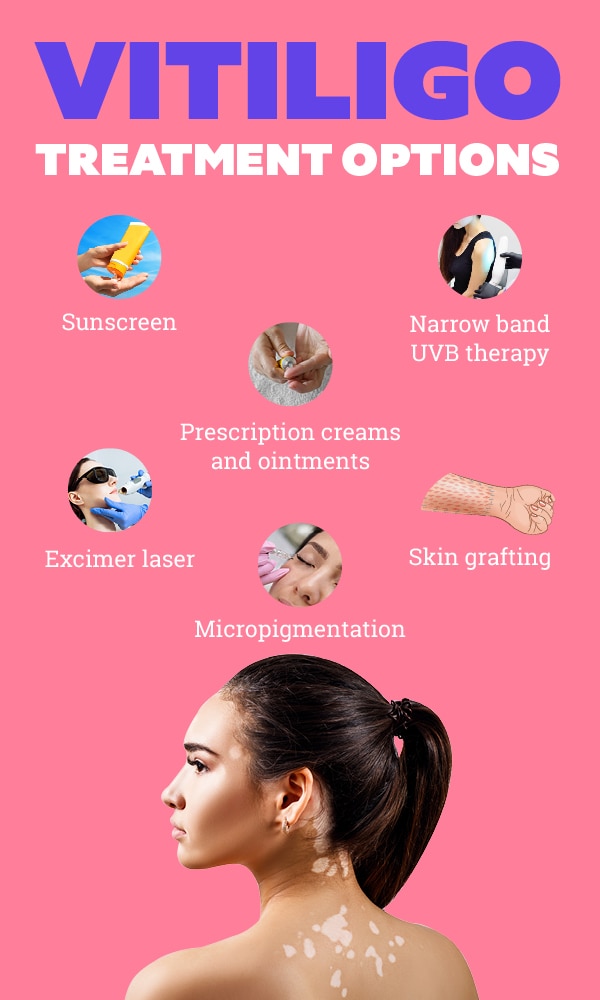There are several options for vitiligo treatment. PUVA is a form of laser therapy. This treatment is administered at a medical center or outpatient center. It is typically applied twice daily for a year or more. PUVA is effective on the face, arms, and legs, but is less effective on the hands. It should be used carefully, as there are risks of serious side effects. Elidel is another option, which is similar to protopic but can be used at home.
Topical calcineurin inhibitors are also an option. These are effective for treating small areas of depigmentation, but the FDA has warned of a potential link to skin cancer and lymphoma. Narrow band UVB is another treatment option, and can slow the progression of active vitiligo. These treatments may be necessary twice a week or more, and take several months to see results.
The most common treatment for vitiligo is corticosteroid cream. Corticosteroids can restore the color of discolored skin, but it may take several months to see significant results. If the symptoms are mild, they may be enough to suppress the condition and prevent the discoloration from spreading. If the disease progresses rapidly, corticosteroid tablets may be the best option. These medications can be expensive and should only be used in combination with other treatments for vitiligo.
There are many different treatments for vitiligo, including laser treatment, medication, and a combination of the two. Light treatment is the most common option and can last three to six months. Some patients find it most effective to treat a small area of vitiligo. However, the skin graft method is not always successful and there is a high risk of scarring and infection. Apart from the risk of infection, it can also lead to patchy repigmentation.
Other treatments for vitiligo include calcineurin inhibitors. They can reduce inflammation and lower the immune response and are often the first choice for treating vitiligo. Although calcineurin inhibitors are very effective, they may be too expensive for some patients. Other options include surgery. If vitiligo is severe, a doctor may use a laser to remove the discolored areas.

Whitening ointments can be used to treat small patches of vitiligo. But these products are not suitable for the elderly or children. Some people may not respond to medication and must undergo surgery. Various types of PUVA are available from the healthcare facility and are recommended for people with large vitiligo. These creams contain a special ingredient known as psoralen, which can darken the stain.
Blister grafting is another method. The dermatologist creates a blister on the pigmented area of the body and then transplants the top of the blister to the discolored area. This treatment is recommended only in extreme cases when pigmentation loss is widespread and if other treatment options have failed. The skin will eventually recolor. Cell suspension transplantation is another treatment option for vitiligo that you can learn more about at medicalss.net.
The best treatments for vitiligo are those that target the underlying problem. A calcineurin inhibitor ointment can help prevent pigmentation in areas affected by vitiligo. Retinoid ointment is an important component of retinoids. This can result in a white spot appearing in one area of the body. In addition, a retinoid may help stop the progression of vitiligo.
The most common treatment for vitiligo is corticosteroid cream. This will help restore skin color. But it takes several months to achieve the effect, and it is not suitable for people with large areas of discolored skin. In addition, corticosteroid creams have side effects such as thinning of the skin and streaks. Before starting any type of treatment, it is best to discuss possible side effects with your doctor and consult the site blinkhealth2018.com.
Phototherapy is a proven treatment for vitiligo. This treatment includes exposure to ultraviolet light and oral psoralen. Psoralen can also be applied to the affected area by immersing it in a bath of water. Despite the effectiveness of these treatments, the risk of skin cancer is still a concern, although it is lower than with other treatments for vitiligo.